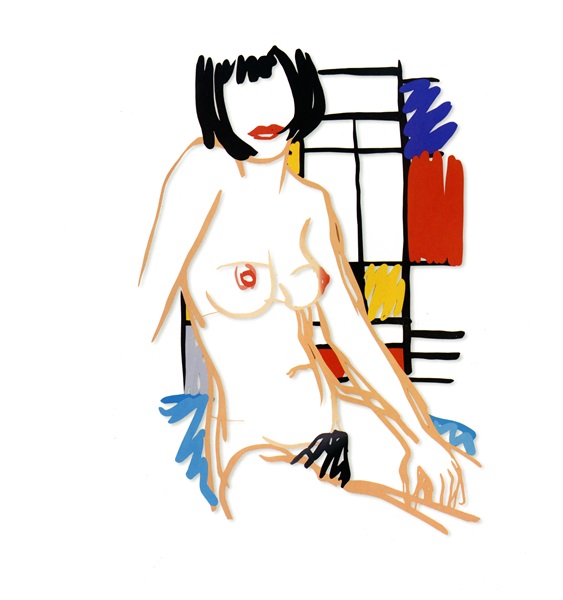
Is there hidden value in the market for works by Pop artist Tom Wesselmann? We decided to go into auction data at artnet as well as talk to dealers and collectors and this is what we found.
“Yes” said several dealers we spoke with. But, they caution, it may take time for this market to catch up with the demand for other Pop artists and get fully sorted out.
“We feel that the market for Wesselman is undervalued,” said Mathias Rastorfer, CEO of Gmurzynska Galleries, where a show of the artist’s 1980s and ’90s steel cutouts titled “A Line to Greatness: Tom Wesselmann’s Steel Drawings” opens February 14. Rastorfer says there has been “a lack of comprehensible direction in the market for Wesselmann, namely in terms of price structure and gallery representation since the artist’s death in 2004.” No one gallery or dealer represents the estate and all kinds of works come up at auction, good and bad.
Tom Wesselmann Smoking cigarette no. 1 (1980) Oil on wood and masonite, formica base.
Photo: Courtesy Galerie Gmurzynska, St. Moritz.
The fact that Wesselmann was not as prolific as some of his Pop artist peers, including Andy Warhol, and Roy Lichtenstein, as well as the dearth of great works by him coming to the auction block in recent years has made the artist’s auction price performance somewhat erratic: see the graph above. According to the artnet Price Database, the current record for Wesselmann is $10.7 million, set at Sotheby’s New York in May 2008 for Great American Nude No. 48 (1963), a mixed-media work consisting of oil and collage on canvas, acrylic and collage on board, enameled radiator, and assemblage. The second highest price for Wesselmann was also achieved in May 2008, at Christie’s, for Smoker No. 9 (1973), oil and liquitex gesso on linen, that sold for $6.8 million on an estimate of $4–6 million.
The other thing to note when looking at the data is the wide range and variety of the artist’s works, making price comparisons with other artists more complicated. Lots of small stuff seems to be coming on to the market, which skews average prices. For instance several of the artist’s works were on offer at the London day sales at Bonhams and Phillips this week at prices ranging from $9,000–$230,000. Barbara in the Bedroom (Black Choker) (1979), liquitex, pencil, and paper on collage card, sold above estimate at Bonhams Feburary 12 sale for $308,000. Meanwhile at Sotheby’s London two nights early (February 10), Great American Nude #42 (1962), oil acrylic, fabric and collages,sold for $2.4 million (estimate: $1.06–$1.4 million). Noting that the price was 75 percent above the high estimate, Emilio Steinberger, senior director of Dominique Lévy Gallery, said “works do sell well when the right one comes at the right place.”
And in the larger picture, as Rastorfer points out, prices on average increased about 17 percent from 2002.
Tom Wesselmann Great American Nude No. 48 (1963) sold for $10.7 million at Sotheby’s New York in May 2008. It is still the highest price at auction for the artist. Photo: Courtesy Sotheby’s.
“Wesselman made far fewer paintings than Warhol or Lichtenstein and important works have not come up at auction for quite a while,” said Steinberger. He has worked closely with the estate and formerly with the artist himself for over a dozen years. Steinberger says private sale prices and offers have topped $10 and $11 million and that works don’t always make it to the auction block because collectors fear the effects of “a lack of comparable sales” on pricing or simply hold on to the great works and don’t want to sell.
Steinberger says the most in-demand works are always those from the 1960s to early ’70s, particularly the nudes, which he says “are definitely the most in demand and iconic works, followed by still lives and landscapes.” His erotically charged Smoker series—often depicting lit cigarettes dangling from a woman’s full, pouting and painted lips—has also proven extraordinarily popular with collectors. The third highest price at auction, $5.6 million, was achieved at Sotheby’s New York in May 2007 for Smoker #17 (1975), oil on shaped canvas (estimate: $2.5–3.5 million).
Rastorfer is hoping the show of steel cut-outs will bring attention to another aspect of the artist’s work. “They are one-of-a-kind in 20th century art, both in their technical execution as well as in their conception and artistic impact. Wesselmann, having always been an outstanding draftsman, wanted to preserve with his cut-outs the process and the immediacy of drawings from life, making them seem almost miraculously drawn in raw steel. Hanging such a work on the wall is like having the artist drawing in your own home.” Prices for the steel cut-out range from $400,000 to $700,000, he notes.
Both Rastorfer and Steinberger agree there is strong collector demand for Wesselmann’s work in the US and Europe. Steinberger says, “Wesselmann was always very popular in Europe. Like many Pop artists that Europeans buy, the interest first started in Italy and Switzerland and continues there today.” He also noted growing regional interest in Korea. Rastorfer agreed, saying “sales in Europe are increasing as well as in Brazil. The Far East I believe holds more potential for Wesselmann’s future market as does the Middle East.”
Institutional interest has also been on the rise with Wesselmann’s work on display in several Pop art-themed shows internationally. Then there was “Beyond Pop Art: A Tom Wesselmann Retrospective” at the Montreal Museum of Fine Arts, with collaboration from the Tom Wesselmann estate in New York, in 2012. It went to the Virginia Museum of Fine Arts in Richmond, Virginia (April 6–July 28, 2013) and then the Cincinnati Art Museum organized a modified presentation of the exhibition at the Denver Art Museum (July 13–September 14, 2014) and Cincinnati Art Museum (October 31–January 18, 2015).
Interested in seeing which Tom Wesselmann work are for sale on artnet Auctions? Click here.